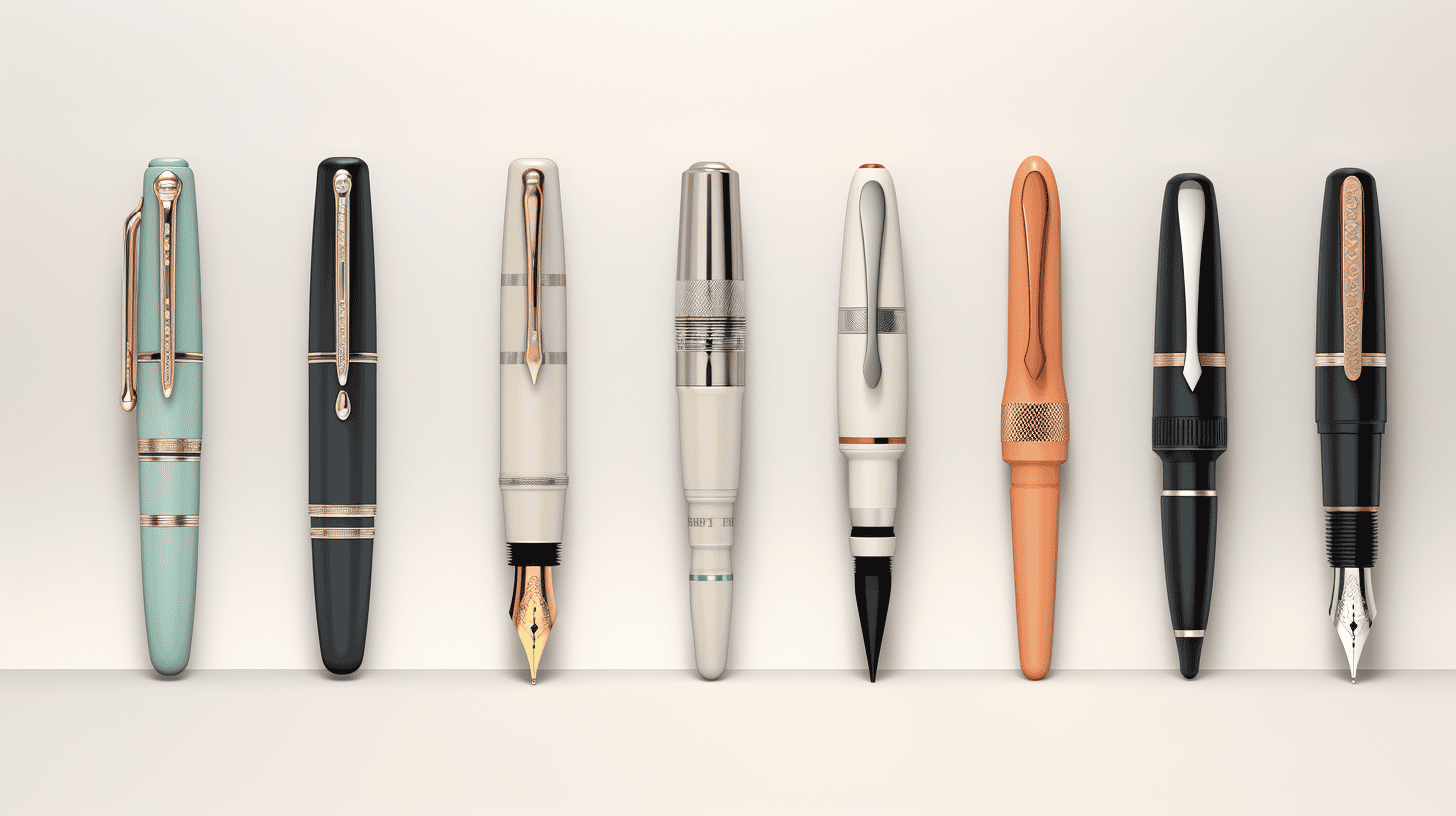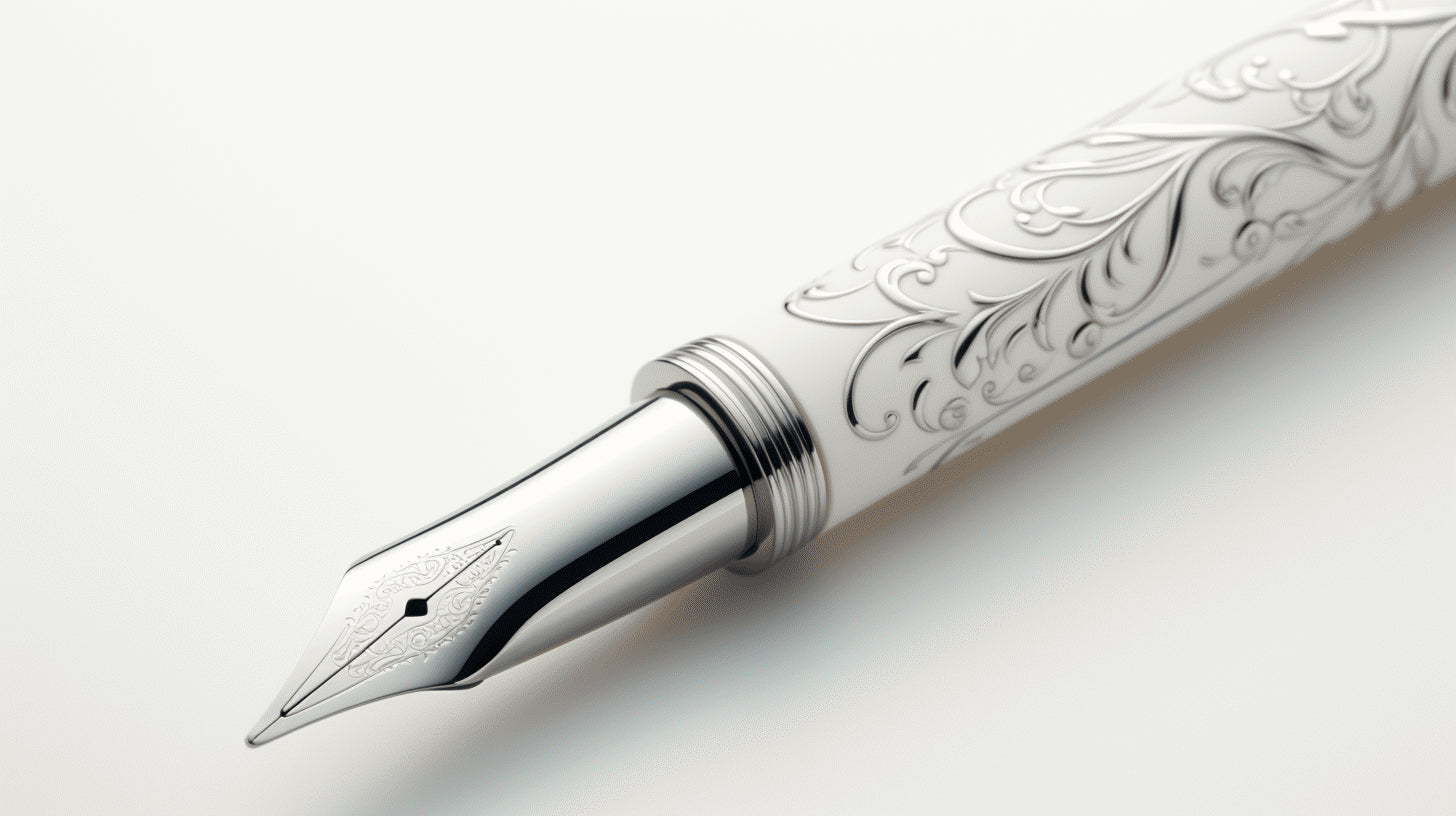
The History and Evolution of Fountain Pens
Fountain pens have a long and storied history that spans centuries. From their humble beginnings as simple quills dipped in ink to the modern and sophisticated writing instruments we see today, fountain pens have undergone numerous transformations throughout the years. They have not only served as tools for communication but also as symbols of elegance, craftsmanship, and personal expression.
In this article, we will delve into the fascinating history and evolution of fountain pens, exploring their origins, the innovations that have shaped them, and their place in the present-day market. We will also discuss the global appeal of fountain pens, their popularity among younger generations, and the future projections for this enduring writing instrument.
So, grab your favorite fountain pen, sit back, and embark on a journey through time as we explore the captivating story behind these remarkable writing tools.
Origins of Fountain Pens
Fountain pens have a long and fascinating history that dates back centuries. These elegant writing instruments have evolved significantly over time, but their origins can be traced back to ancient civilizations. So, where did the concept of the fountain pen begin? Let's dive into the history and uncover its origins.
-
Ancient Beginnings
- The idea of a pen that could hold and distribute ink dates back to ancient civilizations such as Egypt, where reed pens were used with liquid ink.
- In ancient Rome, scribes used pens made of lead or bone, which were dipped into ink and then used for writing.
-
Medieval Innovations
- The Middle Ages brought about advancements in writing instruments, with quills made from bird feathers becoming popular.
- Quills were dipped in ink and provided a more precise writing experience compared to their predecessors.
-
The Birth of the Fountain Pen
- The earliest versions of the fountain pen as we know it today appeared in the 17th century.
- In 1636, the German inventor Daniel Schwenter created a pen with a hollow shaft that could be filled with ink.
- However, it wasn't until the 19th century that significant developments in fountain pen design took place.
-
The Modern Fountain Pen
- In the 19th century, the invention of the steel nib brought about a revolution in fountain pen technology.
- In 1884, Lewis Waterman patented the first practical fountain pen, which featured a feed system that regulated the flow of ink.
- This invention paved the way for numerous innovations and improvements in fountain pen design.
Today, fountain pens are cherished not only for their functionality but also for their aesthetic appeal and the joy they bring to the act of writing. They offer a smooth and effortless writing experience, making them a favorite among writers, artists, and pen enthusiasts.
If you want to learn more about fountain pens and their fascinating history, check out this comprehensive guide on What is a Fountain Pen. It provides insight into the different types of fountain pens, how they work, and why they are beloved by so many.
Evolution and Progression of Fountain Pens
Fountain pens have come a long way since their inception in the early 17th century. From simple quill pens to intricate, finely-crafted writing instruments, the evolution of fountain pens is a testament to humanity's constant pursuit of innovation and refinement. In this section, we will explore the fascinating journey that fountain pens have taken over the centuries.
Quill Pens: The Precursor to Fountain Pens
Before fountain pens revolutionized the art of writing, quill pens were the go-to writing instruments. Made from the feathers of birds such as geese, swans, and crows, quills provided an effective means of transferring ink onto paper. However, they had their limitations - the ink supply had to be continuously replenished, and the tips required frequent reshaping.
The Birth of the Fountain Pen
The concept of a self-contained ink reservoir within a pen dates back to the 10th century, but it wasn't until the 17th century that the modern fountain pen started to take shape. The first recorded patent for a fountain pen-like device was granted to M. Bion in 1702, but it would take several more decades for significant advancements to occur.
The Innovations that Drove Progress
Over the years, numerous inventors contributed to the development of fountain pens. Here are some significant milestones:
- Plunger-Fill Mechanism: In the early 19th century, inventor Petrache Poenaru patented a pen that used a plunger mechanism to draw ink into the reservoir. This innovation paved the way for future designs that eliminated the need for constant dipping and refilling.
- Improved Nibs: Nibs, the tips of fountain pens, underwent several improvements to enhance the writing experience. From the introduction of iridium ballpoints to the development of flexible and gold nibs, these advancements improved ink flow and line variation.
- Ink Delivery Systems: The development of various ink delivery systems played a crucial role in the evolution of fountain pens. From eyedroppers to lever-fill mechanisms and vacuum-fillers, these innovations made refilling easier and more convenient.
From Vintage to Modern: The Fountain Pen Today
In the modern era, fountain pens have transformed from a necessity to a luxury item coveted by collectors and writing enthusiasts alike. They are available in a wide range of designs, materials, and nib options, catering to diverse preferences. Some notable advancements include:
- Materials: Fountain pens now come in an array of materials, including precious metals, fine woods, acrylics, and even innovative materials like carbon fiber.
- Ink Options: Today, fountain pen users have access to a vast selection of inks, ranging from traditional blue, black, and sepia tones to vibrant colors and shimmering pigments.
- Specialty Nibs: Different nib designs, such as flex nibs for expressive writing and stub nibs for calligraphy, allow users to customize their writing experience according to their preferences.
As technology continues to advance, it's exciting to think about what the future holds for fountain pens. One thing is certain - despite the rise of digital communication, the allure of putting pen to paper with a beautifully crafted fountain pen remains timeless. The journey of the fountain pen continues, evolving and progressing with each passing year.
To delve deeper into the fascinating history and evolution of fountain pens, check out Evolution of Fountain Pens.
Present Day Market for Fountain Pens
In today's digital age, where most of our communication is done through keyboards and touchscreens, the market for fountain pens may seem niche. However, the allure and timeless elegance of these writing instruments continue to captivate enthusiasts and collectors alike. Let's take a closer look at the present-day market for fountain pens and the factors contributing to its growth.
Global Market Overview
The global fountain pen market has shown steady growth in recent years. According to industry reports, the market value reached USD 955.94 million in 2022, with a projected compound annual growth rate (CAGR) of 2.49%. This trend is expected to continue, with a forecasted market value of USD 1107.77 million by 2030, showcasing a CAGR of 2.51%. These figures indicate a promising future for fountain pen manufacturers and retailers.
Sales Channels
Traditionally, brick-and-mortar stores were the primary sales channels for fountain pens. However, the landscape has shifted, with the advent of e-commerce and online marketplaces. Online stores are emerging as a lucrative platform for fountain pen enthusiasts to explore a wide range of options, conveniently search for specific models or brands, and make purchases from the comfort of their own homes. Additionally, online platforms often offer detailed product descriptions and user reviews, aiding buyers in making informed decisions.
If you're looking to buy fountain pens online, there are numerous reputable sources to consider. Wood Fountain Pens has compiled a comprehensive guide highlighting the top places to buy fountain pens online. This resource can assist you in finding reliable online retailers and platforms to ensure a smooth shopping experience.
Interest Among Younger Generations
While the digital age has transformed the way we communicate, it has also sparked a resurgence of interest in analog activities. Younger generations, in particular, are drawn to experiences that offer a break from screens and provide a tangible connection to the world around them. This renewed fascination with analog writing instruments, including fountain pens, has contributed to the growth of the market. Millennials and Generation Z are appreciating the unique craftsmanship, individuality, and personal expression that fountain pens offer, driving their increased demand.
In addition, high-quality writing tools, such as fountain pens, are gaining popularity due to their ability to evoke sensory experiences and enhance the pleasure of writing. The market has responded to this demand, with a shift towards premium and personalized fountain pens that offer unique designs, materials, and customization options.
With the global market for fountain pens poised for sustained growth and online sales channels providing easy access to a wide range of options, now is an exciting time for fountain pen enthusiasts and newcomers alike. So, whether you're a seasoned collector or a beginner looking to embark on your fountain pen journey, the market is ready to fulfill your writing desires.
Fountain Pen Ink Market
The fountain pen ink market is a thriving industry that continues to gain momentum year after year. With the rise in popularity of fountain pens as a writing instrument, there is a growing demand for high-quality ink to accompany these elegant pens. According to industry projections, by 2028, the global fountain pen ink market is expected to reach a staggering US$ 3,287.53 million, with a compound annual growth rate (CAGR) of 5% over the forecast period. This indicates a significant opportunity for businesses operating in the fountain pen ink sector to capitalize on this rising demand and expand their market reach.
Factors Driving Market Growth
Several factors contribute to the growth and robustness of the fountain pen ink market. These include:
- Increasing Interest in Calligraphy and Handwriting: As individuals seek to personalize their communication and express their creativity, there has been a renewed interest in calligraphy and the art of beautiful handwriting. Fountain pens, with their smooth nibs and wide range of ink colors, offer a delightful writing experience that enhances the aesthetics of written text.
- Preference for Sustainable and Environmentally Friendly Products: In recent years, there has been a shift in consumer preferences towards sustainable and eco-friendly products. Fountain pen ink, which can be refilled and reused, aligns well with this preference as it reduces waste and promotes a more sustainable writing experience.
- Rising Pen Enthusiast Community: The fountain pen community is a passionate group of discerning individuals who appreciate the craftsmanship and elegance of fine writing instruments. With a growing community of pen enthusiasts, fueled by social media platforms and online forums, there is a constant demand for new and unique fountain pen ink options.
- Wide Range of Ink Colors and Varieties: Fountain pen ink comes in a vast array of colors, ranging from traditional blues and blacks to vibrant shades like purple, green, and orange. This diverse color palette allows users to personalize their writing and adds a touch of creativity to their correspondence.
Competitive Landscape
In the competitive landscape of the fountain pen ink market, several key players dominate the industry. These include:
| Company | Product Offering |
|---|---|
| Pilot Corporation | Iroshizuku, Namiki, and Varsity |
| Montblanc International GmbH | Montblanc Ink |
| Diamine Inks Ltd. | Diamine Ink Bottles |
| J. Herbin | Herbin Ink |
| Sailor Pen Co., Ltd. | Sailor Ink Studio |
These companies have established themselves as leaders in the market, leveraging their reputation for producing high-quality ink products. However, there is ample room for new entrants to carve out a niche in this growing market by offering unique and innovative fountain pen ink formulations.
In conclusion, the fountain pen ink market is positioned for substantial growth in the coming years. The increasing interest in calligraphy and handwriting, preference for sustainable products, a vibrant pen enthusiast community, and the wide range of ink colors and varieties are key factors driving this market expansion. With the right product offerings and marketing strategies, businesses in the fountain pen ink industry can tap into this burgeoning market and secure a profitable position.
Future Projections for the Fountain Pen Market
In recent years, the fountain pen market has experienced a resurgence in popularity. With its timeless charm and elegant writing experience, fountain pens have captured the interest of both seasoned pen enthusiasts and newcomers alike. But what does the future hold for this classic writing instrument? Let's take a look at some future projections for the fountain pen market.
- According to industry experts, the global pens market is estimated to grow at a compound annual growth rate (CAGR) of 2.5% from 2022 to 2030[1]. This projected growth indicates a promising future for fountain pens, as they continue to carve out their place in the writing instrument market.
- Experts also forecast a significant growth rate for the fountain pen market specifically until 2025[2]. This demonstrates the ongoing demand for these luxurious writing tools and suggests that fountain pens will continue to be sought after by pen enthusiasts and collectors.
Despite the rise of digital technology and the convenience of modern ballpoint pens, fountain pens offer a unique writing experience that cannot be replicated. Here are some reasons why the fountain pen market is projected to thrive in the coming years:
- Writing Experience: Fountain pens provide a smooth and effortless writing experience, with their delicate nibs gliding across the paper. This tactile experience and the ability to control ink flow allow for a personalized writing style that enthusiasts find highly appealing.
- Personalization and Collectability: Fountain pens offer a wide range of options for personalization, allowing users to choose different nib sizes, materials, and designs that suit their preferences. Additionally, fountain pens have a collectible aspect, with many enthusiasts building their fountain pen collections over time.
- Sustainable Choice: With a focus on sustainability and reducing waste, fountain pens provide an eco-friendly alternative to disposable pens. By using refillable ink cartridges or converters, fountain pen users can reduce their environmental impact while enjoying the long-lasting performance of their pens.
As the fountain pen market continues to evolve, innovations and trends are also shaping its future. From new materials and designs to advancements in nib technology, fountain pen manufacturers are constantly pushing the boundaries to enhance the writing experience and cater to evolving consumer demands.
In conclusion, the future looks bright for the fountain pen market. With a growing global pens market and a continued interest in fountain pens, we can expect to see this timeless writing instrument thrive in the years to come. Whether you're a seasoned collector or a casual user, the allure of the fountain pen is undeniable.
[1] Source
[2] Source
Conclusion
In conclusion, fountain pens have a long and storied history, evolving from simple reed pens to the beautifully crafted writing instruments we know today. They have captured the hearts of writers and pen enthusiasts alike, offering a unique and satisfying writing experience.
As we look to the future, it is evident that the fountain pen market continues to thrive, with a growing global demand for these timeless treasures. Sales channels are expanding, catering to both traditional brick-and-mortar stores and online platforms, making it easier than ever to acquire the perfect fountain pen.
What's particularly exciting is the rising interest among younger generations. Despite the digital age we live in, many young individuals are discovering the joys of handwriting and the aesthetic appeal of fountain pens. This resurgence in appreciation for traditional writing instruments bodes well for the future of the fountain pen market.
If you're looking to elevate your writing experience to new heights, consider exploring the world of wooden fountain pens. Crafted by hand with precision and care, Wood Fountain Pens offers a collection of exquisite pens that redefine the joy of writing. Visit Wood Fountain Pens here to discover the allure of these elegant and captivating instruments.
With their timeless appeal and unmatched elegance, fountain pens continue to inspire and enchant writers across the globe. Embrace the allure of fountain pens and let your thoughts flow effortlessly onto paper, capturing the essence of every word with grace and precision. Experience the joy of writing with Wood Fountain Pens and discover a new level of craftsmanship and beauty in the art of penmanship.
Frequently Asked Questions
-
When were fountain pens first invented?
Fountain pens were first invented in the 10th century by the Egyptians who used reed pens that had a hollow stem for ink flow.
-
Who was the inventor of the modern fountain pen?
Lewis Waterman is credited with inventing the modern fountain pen in 1884. He developed a system that prevented leakage and allowed for a continuous and controlled ink flow.
-
How do fountain pens work?
Fountain pens work by using capillary action. The ink is stored in a reservoir and is drawn into the nib through a feed. When the nib comes into contact with paper, the ink is transferred from the reservoir to the paper.
-
How have fountain pens evolved over time?
Fountain pens have evolved significantly over time. They have seen improvements in materials, ink flow mechanisms, fill mechanisms, and design aesthetics. Today, there are various types of fountain pens available, catering to different writing styles and preferences.
-
Are fountain pens still popular today?
Yes, fountain pens are still popular today among enthusiasts, collectors, and individuals who appreciate the art of writing. They offer a unique writing experience, better control, and the ability to use a wide range of ink colors.







Leave a comment
This site is protected by hCaptcha and the hCaptcha Privacy Policy and Terms of Service apply.